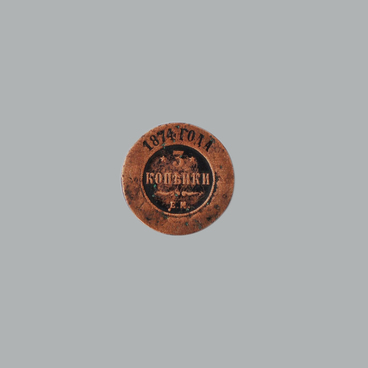The Karasuksky Regional Museum’s collection includes a solid copper three-kopek coin, issued during the reign of Alexander III. This design of coin was regularly issued and circulated throughout all of the empire’s territories, according to the catalog ‘Russian Coins 1700-1917’. It corresponds with the type of coin produced at the Saint Petersburg Mint between 1867 and 1916. The coin weighs in at 9.83 grams, as the ratio of copper to rubles for this coin amounted to 50 rubles from 16.3 kilograms of copper. In 1867, ten of these coins would buy you around 16 kilograms of rye flour or around 8 kilograms of wheat flour.
Traditionally the small State coat of arms was displayed on the coin’s obverse. This coat of arms depicts a two-headed eagle under three crowns, with an orb and scepter. In the upper half of the coin, a raised inscription is clear to read: “RUSSIAN COPPER COIN”. In the lower half of the coin, there is a depressed inscription, reading: “THREE KOPEKS”. It is possible to see the Saint Petersburg Mint’s designation below the border on the coin’s reverse - the small letters “S.P.B”. The three-kopek coin’s edge is cord-like, made up of vertical cuts.
In 1867, the Russian empire changed the design on all of its copper coins. For the first time, raised and depressed letters were combined on the obverse and reverse of Russian coins in order to make it more difficult to counterfeit. The copper to coin ratio was also changed - 16.3 kilograms of copper now needed to be made into 50 rubles of a particular coin type rather than the previous 32. This ratio remained the same until imperial minting stopped in 1917.
Minting of the new three-kopek copper started at the same time at the Saint Petersburg and Yekaterinburg mints, however the Yekaterinburg Mint was shut down in 1876 due to the transfer of the department to the Ministry of State Property.
In 1868, the Warsaw mint was shut down and token coins ceased to be minted for Poland. Token coins are coins whose purchasing power was higher than the value of the metals contained within the coin. In 1871, some of the mint’s coin and metal stamps, the collection cabinets in which they were stored, machines and archives were transferred to the Saint Petersburg Mint. The majority of burden for minting the Empire’s copper coins fell on the Saint Petersburg mint, and when by 1896 the mint required repairs and modernization, orders were sent to the Birmingham mint in Great Britain. These coins were likewise stamped with the designation SPB, and the coins minted English are no different from the Russian coins.
Traditionally the small State coat of arms was displayed on the coin’s obverse. This coat of arms depicts a two-headed eagle under three crowns, with an orb and scepter. In the upper half of the coin, a raised inscription is clear to read: “RUSSIAN COPPER COIN”. In the lower half of the coin, there is a depressed inscription, reading: “THREE KOPEKS”. It is possible to see the Saint Petersburg Mint’s designation below the border on the coin’s reverse - the small letters “S.P.B”. The three-kopek coin’s edge is cord-like, made up of vertical cuts.
In 1867, the Russian empire changed the design on all of its copper coins. For the first time, raised and depressed letters were combined on the obverse and reverse of Russian coins in order to make it more difficult to counterfeit. The copper to coin ratio was also changed - 16.3 kilograms of copper now needed to be made into 50 rubles of a particular coin type rather than the previous 32. This ratio remained the same until imperial minting stopped in 1917.
Minting of the new three-kopek copper started at the same time at the Saint Petersburg and Yekaterinburg mints, however the Yekaterinburg Mint was shut down in 1876 due to the transfer of the department to the Ministry of State Property.
In 1868, the Warsaw mint was shut down and token coins ceased to be minted for Poland. Token coins are coins whose purchasing power was higher than the value of the metals contained within the coin. In 1871, some of the mint’s coin and metal stamps, the collection cabinets in which they were stored, machines and archives were transferred to the Saint Petersburg Mint. The majority of burden for minting the Empire’s copper coins fell on the Saint Petersburg mint, and when by 1896 the mint required repairs and modernization, orders were sent to the Birmingham mint in Great Britain. These coins were likewise stamped with the designation SPB, and the coins minted English are no different from the Russian coins.



